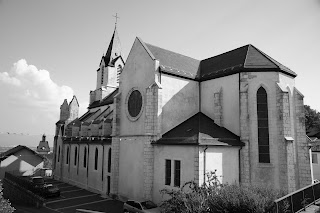
St. Pierre Church
The Jura Mountains are a small mountain range located north of the Alps, separating the Rhine and Rhone rivers and forming part of the watershed of each. The mountain range sensu Johann Gottfried Ebel (* 1764, † 1830) is located in France, Switzerland, and Germany. The name “Jura” is derived from the Celtic root "jor" which was latinised into "juria", meaning forest (i.e., "Jura" is forest mountains.

The facade of the St. Pierre Church in Gex, France

St.Pierre Church-Gex, France

St. Pierre in black & white.
In France, it covers essentially the region of Franche-Comté, stretching south to the region of Rhône-Alpes east of the department of Ain, where the range reaches its peak at Le Crêt de la Neige. The southern end of the French Jura is in the northwest of the department of Savoie. The north end is in the very south of Alsace. Roughly 1600 square kilometers of the mountain range is protected within the Jura Mountains Regional Natural Park.
In Switzerland, the range covers the western border, with France in the Cantons of Basel, Solothurn, Jura, Bern (ie Bernese Jura), Neuchâtel, Vaud, and Germany in the Canton of Schaffhausen. It includes also the Canton of Basel-Landschaft. The Swiss Jura has been industrialized since the 18th century and was a major center of the Watch-making industry. Therefore, there are relatively large cities at very high altitudes, such as La Chaux-de-Fonds, Le Locle, and Sainte-Croix (city also renowned for its musical boxes. This area has had a marked decline in population since about 1960. The Swiss Jura is also one of the three distinct geographical regions of Switzerland, the other being the Swiss plateau and the Swiss Alps.
Romainmôtier is a Swiss village in the canton of Vaud. It is in the Jura-Nord district. As of 2007 the village had 470 residents. The village is known for its abbey. The initial phase of the abby begain during the Cluniac movement in the 11th century.

Houses in Romainmôtier, Switzerland

The main street in Romainmôtier

The clock tower
The Cluniac Reform
The Cluniac (Clunian) Reform was a series of changes within medieval monasticism, focused on restoring the traditional monastic life, encouraging art, and caring for the poor. The movement is named for the Abbey of Cluny in Burgundy, where it started within the Benedictine order. The reform was largely carried out by Saint Odo (c. 878 – 942) and spread through France (Burgundy, Provence, Auvergne, Poitou), England, and much of Italy and Spain.

The Abbey of Romainmôtier

The Abbey in B&W

The Abbey's steeple
The impetus for the reform was corruption within the church, particularly simony and concubinage. These abuses were thought to be a result of secular interference in the monasteries, and of the Church's tight integration with the feudal and manorial systems. At the same time, the Papacy wished to reassert control of all clergy and stop the investiture of Bishops by secular rulers. Since a Benedictine monastery required land, it needed the patronage of a local lord. However, the lord would often demand rights and assert prerogatives that interfered with the operation of the monastery. The Cluny reform was an attempt to remedy these practices in the hope that a more independent abbot would better enforce the Rule of Saint Benedict.

Inside the Abbey of Romainmôtier
William of Aquitaine formed the first Cluny monastery in 910 with the novel stipulation that the monastery would report directly to the pope rather than to a local lord. This meant the monastery would be essentially independent, since the pope's authority was largely theoretical at that distance. Further, the Abbot of Cluny retained authority over the daughter houses his monks founded. By the twelfth century the Congregation of Cluny included more than a thousand monasteries.

The gothic infleuence
Among the most notable supporters of the reform were Pope Urban II, Lambert of Hersfeld, and Richard of Verdun. The Cluniac reforms encouraged the Church in the West to be more attentive to business and gave impetus to attempts to reassert control over the Eastern Church.
During its height (c. 950–c.1130) the Cluniac movement was one of the largest religious forces in Europe. At least as significantly as their political consequences, the reforms demanded greater religious devotion. The Cluniacs supported the Peace of God, and promoted pilgrimages to the Holy Lands. An increasingly rich liturgy stimulated demand for altar vessels of gold, fine tapestries and fabrics, stained glass, and polyphonic choral music to fill the Romanesque churches.

Gothic stained glass window
In 1098 Robert of Molesme led a band of 21 Cluniac monks from their abbey at Molesme to establish a new monastery. The group hoped to cultivate a monastic community in which monks could live in stricter observance of the Rule of Saint Benedict. The monks acquired a plot of marsh land just south of Dijon called Cîteaux (Latin: "Cistercium"), and so founded the Cistercian order.
In Germany, the Jura is lower in altitude, stretching into Bavaria in the Swabian and Franconian plateaus.
The mountain range has given its name to the French department of Jura, the Swiss Canton of Jura, and the Jurassic period of the geologic timescale.
No comments:
Post a Comment